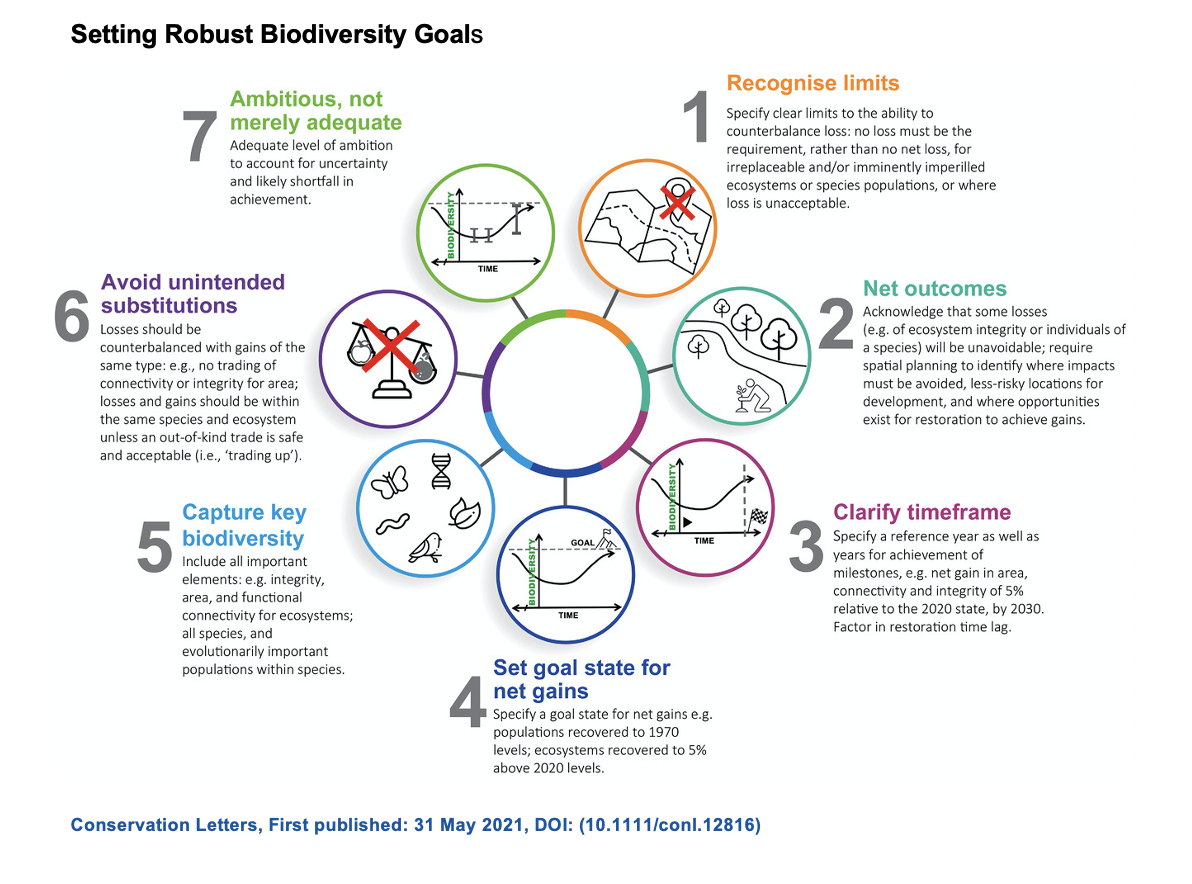As the Parties to the Convention on Biological Diversity (CBD) work to agree on a new global framework to stop and reverse declines in Earth’s biodiversity, scientists publishing in Conservation Letters argue for improved alignment between environmental outcome goals and specific actions and offer key principles to guide the goal setting necessary to achieve the CBD’s 2050 vision: living in harmony with nature.
The Gist
“If the Global Biodiversity Framework is to successfully halt and reverse biodiversity loss,” says co-author Linda Krueger, TNC’s director of biodiversity and infrastructure policy, “explicit measurable goals are needed to set the course for action. Unfortunately, the current draft goals and targets fail to set out these clear outcomes.”
The paper “Setting Robust Biodiversity Goals,” defines seven principles to limit risk of perverse environmental outcomes that can result when poorly articulated environmental outcome goals leave room for loose interpretation. More clearly specified net outcome goals can help strengthen the Global Biodiversity Framework (GBF) in particular, and conservation-goal setting in general.
 Including these principles in the outcome goals of the GBF would, the authors note, require some key changes in current wording, and suggest ecosystem goal language that would be consistent with their recommendations, “No loss of irreplaceable ecosystems and sites essential for biodiversity conservation; no net loss in integrity, area, ecosystem function, and connectivity for all freshwater, marine and terrestrial ecosystems relative to 2020 levels by 2030; net recovery in ecosystem area and integrity of at least [10%] above 2020 levels by 2050.”
Including these principles in the outcome goals of the GBF would, the authors note, require some key changes in current wording, and suggest ecosystem goal language that would be consistent with their recommendations, “No loss of irreplaceable ecosystems and sites essential for biodiversity conservation; no net loss in integrity, area, ecosystem function, and connectivity for all freshwater, marine and terrestrial ecosystems relative to 2020 levels by 2030; net recovery in ecosystem area and integrity of at least [10%] above 2020 levels by 2050.”
The Big Picture
“Reticence about the concept of net environmental outcome goals is understandable,” notes Joe Kiesecker, co-author and TNC’s lead scientist for protection, “it does have a checkered history. To be effective, net outcome goals need to be explicit, unambiguous and practical. And the wording must establish the fundamental distinction between net outcomes at a global or jurisdictional scale, and their more familiar context of offsetting project-level impacts.”
As the authors note, intrinsic variability and place-specificity of biodiversity mean attention to detail is required to ensure biodiversity goals are framed clearly enough to yield a useful and effective framework for driving and monitoring progress. Net outcome goals are necessary because pressures on biodiversity can never be entirely eliminated. It is important to define where losses are acceptable in exchange for gains elsewhere—and where losses are not.
That said, the authors also note that to be realistic and equitable, socio-economic circumstances and historical impacts must be considered in defining the scope and application of no net loss/net gain of biodiversity within different jurisdictions. As such, different countries might have different targets for biodiversity outcomes—but they must sum globally to no net loss/net gain of biodiversity. These different targets might also consider heterogeneity in the practical challenges associated with resources and capacity for implementation—factors often overlooked by decision-makers developing net outcome policies.
The Takeaway
Finally, argue the authors, achieving the UN Sustainable Development Goals (SDGs) will require massive investments in infrastructure and agriculture to transform our energy, food and transportation systems. These investments will place enormous pressures on natural habitats and ecosystems, resulting in inevitable losses of biodiversity. Therefore, net (rather than gross) halting and reversal of declines of ecosystems, species populations, and genetic diversity is likely to be a necessary framing for the CBD’s outcome goals, so that nature and people can thrive together.
Planning in place, at landscape and jurisdiction scales, where land use decisions are made, will be critical to ensure the translation of net outcomes can achieve their intended goals.
References:
Maron, M., Bignoli, D. J., Krueger, L., Kiesecker, J., Kümpel, N. F., ten Kate, K., Milner-Gulland, E. J., Arlidge, W. N. S., Booth, H., Bull, J. W., Starkey, M., Ekstrom, J. M., Strassburg, B., Verburg, P. H., Watson, J. E. M. (2021). Setting robust biodiversity goals. Conservation Letters, e12816. https://doi.org/10.1111/conl.12816




Variation by way of Sexual Reproduction. Minimum Viable Population ensures Adaptive Radiation.